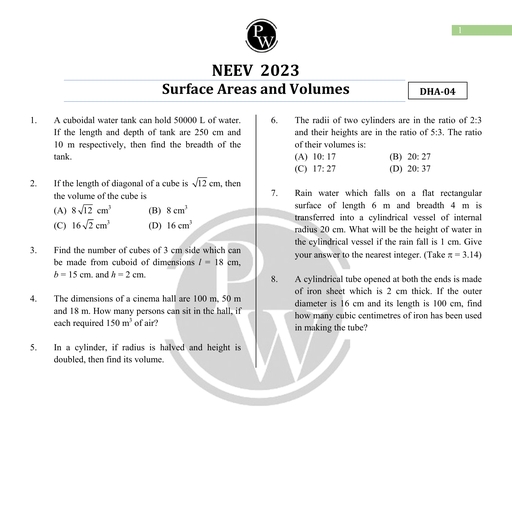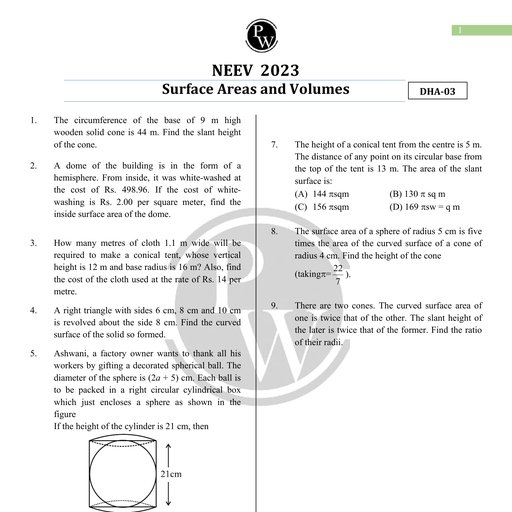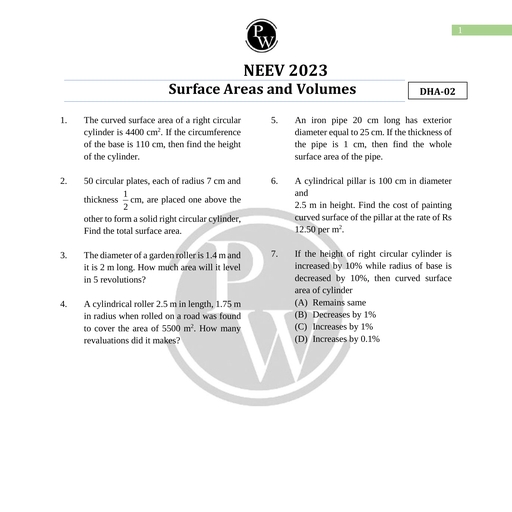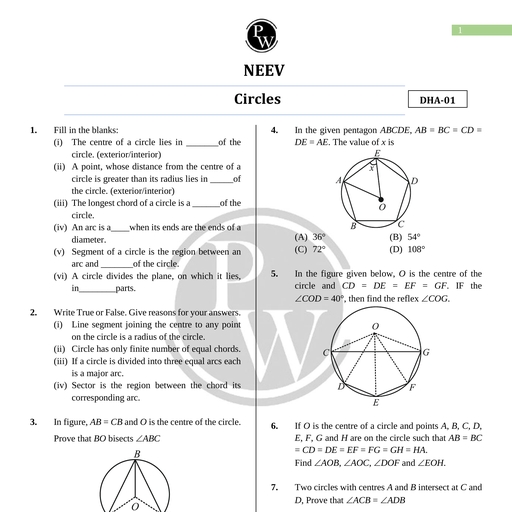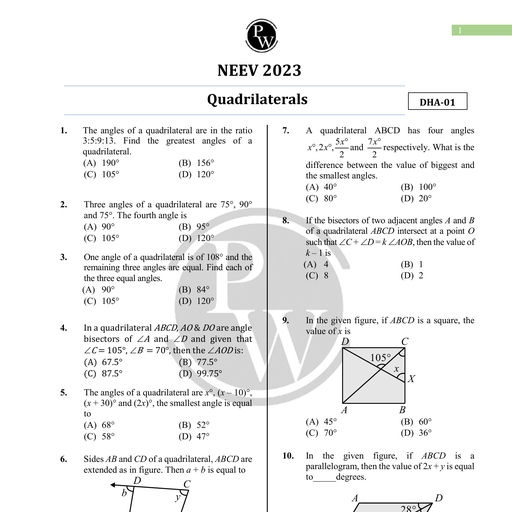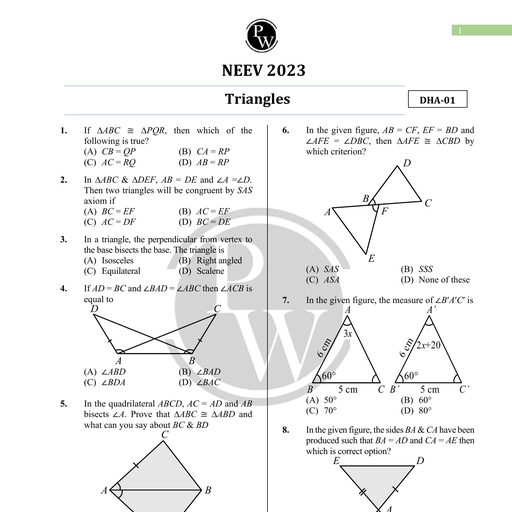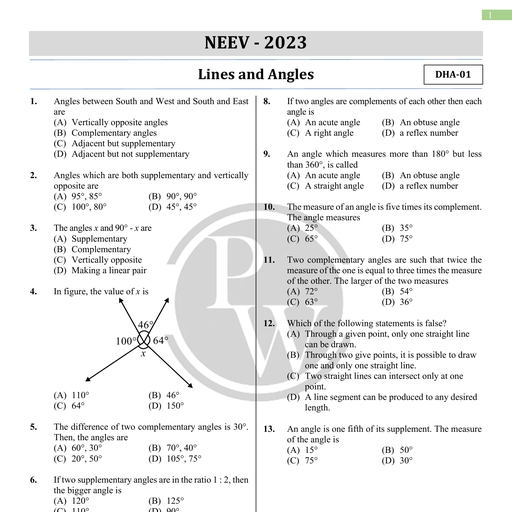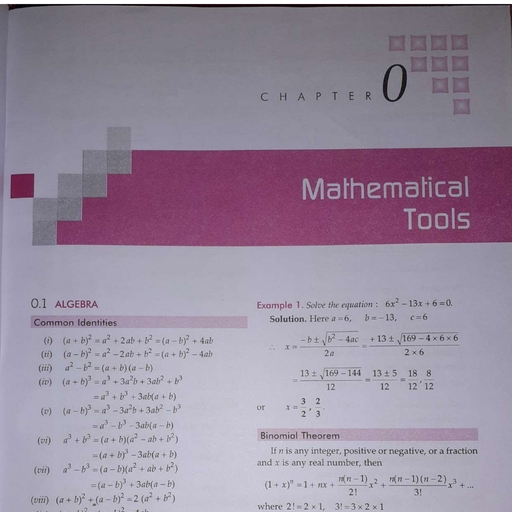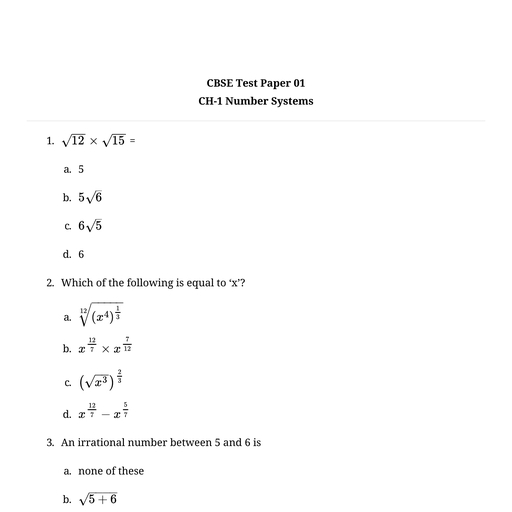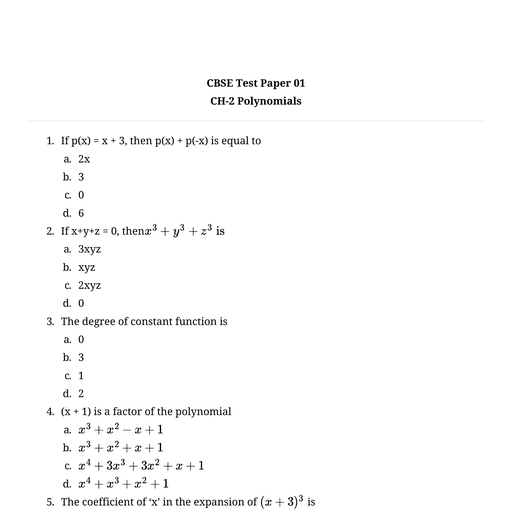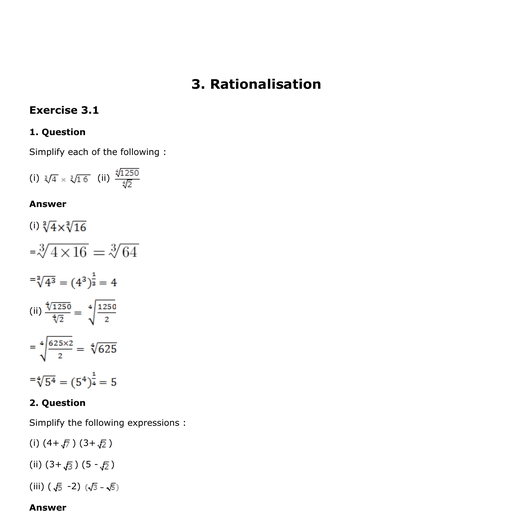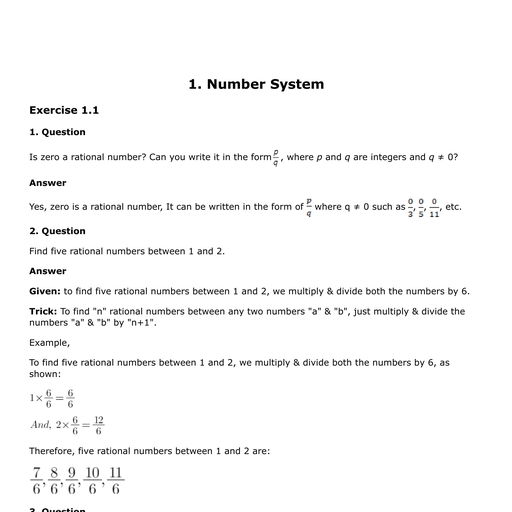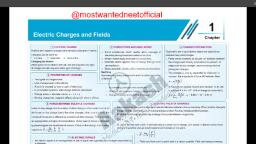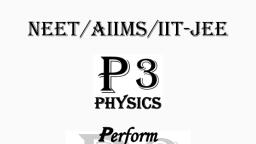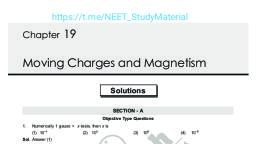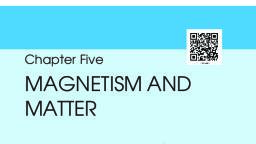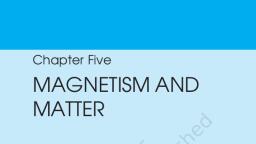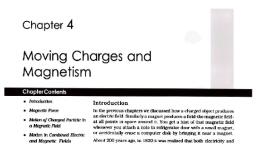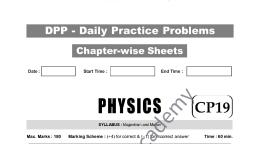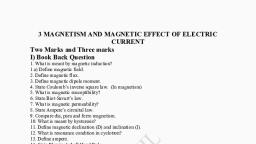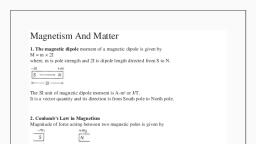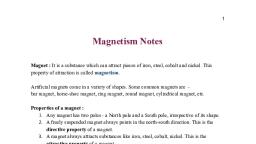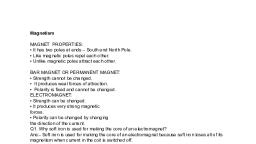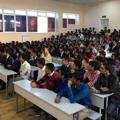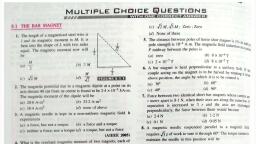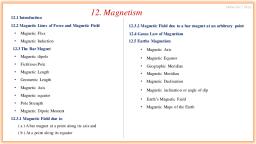Page 1 :
Chapter 5, , Magnetism and Matter, , © Introduction Introduction, , ¢ Bar Magnet The science of magnetism grew from the observation that a certain, ‘i ores could attract small pieces of iron and pointed in certain direction, , 0 "Magnetism and Gaitss's Karn) when kept on floating cork. The ore as originally found in the district, e Earth's Magnetism of Magnesia in Asia minor (now in western Turkey) and therefore named, magnetite. In 800 BC shepherds on the island of Magnesia observed, , e Magnetisationand magnetic _ that the nails in their shoes were glued to the ground due to presence, , Intensity of magnetic ores in the area. The word magnet owes its origin to this, island of Magnesia. Since 400 BC Chinese had been using magnetic, ® — Properties of needles to determine directions while sailing. Caravans used magnetic, , needles to navigate across Gobi desert., © Some Important Definitions, , , , om laeCh BAR MAGNET, Whern iron filings are sprinkled on a sheet of glass placed over a short bar, © Quick Recap magnet, a particular pattern is formed and following conclusions are drawn, , (a) The bar magnet has poles similar to the, positive and negative charge of an electric, dipole., , (b) One pole is designated as north pole and other, as south pole., , (c) When suspended freely, these poles point, approximately towards the geographic north, and south poles., , (d) Like poles repel each other and unlike poles, attract each other., , (e) The poles of a magnet can never be separated., , , , Magnetic Field Lines, , (1) Magnetic field line is an imaginary curve, the tangent to which at any, point gives direction of magnetic field B at that point., , (2) The magnetic field lines of a magnet (or of a solenoid carrying current), form close-continuous loops., , Aakash Educational Services Pvt. Ltd. - Regd. Office : Aakash Tower, 8, Pusa Road, New Delhi-110005 Ph. 011-47623456
Page 2 :
82 Magnetism and Matter Board & Competitive Exams., , (3) Outside the body of magnet, the direction of magnetic field lines, are from north pole to south pole., , (4) No two magnetic field lines can intersect each other. This is, because at the point of intersection, we can draw two tangents., This would mean two directions of magnetic field at the same, point, which is not possible., , (5) Larger the number of field lines crossing per unit area, the, stronger Is the magnitude of the magnetic field 8. B is larger, around region (ii) than in region (i)., , , , , , , CT, , , , (a), (6) Magnetic lines of force come out and go into a magnetic material at any angle., , @” x *, 90, ———3 fr, ——— ————, Uniform magnetic field Non-uniform magnetic field Non-uniform magnetic field, , Pole strength of magnetic charge, , (i) Just like electric charges, a magnetic charge (also called pole strength) +m is assigned to the north pole, and —m to the south pole of a bar magnet. If length of the bar magnet is 2/, then its magnetic moment, is given by, , [Following electrical analogy}, , (ii) Magnetic field strength due to a magnetic pole (hypothetical) at a distance ris given by, , , , m, mr? |, , |F, , B=, , , , , , >, , , , (iii) Unit of pole strength or magnetic charge (m) is ampere-metre., , (iv) A consequence of the fact that magnetic monopoles do not exist is that the magnetic field lines are, continuous and form closed loops. In contrast, the electrostatic lines of force begin on a positive charge, and terminate on the negative charge., , Aakash Educational Services Pvt. Ltd. - Regd. Office : Aakash Tower, 8, Pusa Road, New Dethi-110005 Ph. 011-47623456
Page 3 :
Board & Competitive Exams. Magnetism and Matter 83, , Content Builder, , , , If a magnet is divided into two equal parts such that the cross-sectional area becomes half, each, part will be a magnet with half the pole-strength of the original magnet [Figure (b)]., , , , , , , , , , , , , , , , , , , , , , , , 2 id sats 1, Zi [wena], wf, +m =m | Léwe |, M=mx2 M = Bx an m= mini, , (a) (b) (), , In the figure (c), the original magnet [(figure (a)] has been cut into two equal parts with the crosssection remaining unchanged. In this case each part is a magnet with the original pole-strength m., , Illustration 1: A steel rod has a magnetic moment M. If it is bent into a semicircular arc, find, , its magnetic moment., , Suppose m = pole-strength M = mb, SEE, , L = Length of the rod ( —— om, , The magnetic moment M = mL L, , When the rod is bent in a semicircular arc @), , of radius r, mr = L or, gel, n, , The new effective length = 2r = a, The new magnetic moment is, , M’ = mx2r = 2 _2my- 2m, rv nr nv, , , , Illustration 2: Two identical magnets each of pole-strength m and length L, are joined, perpendicularly to each other as shown in the figure. Find the magnetic moment, of the combination., , +m, (=), , , , +m [& ‘ej -n, , , , , , , , le], , —m, The magnetic moments M, and, Mz of the two magnets are shown, , , , in the Figure. Vectorially Mis the, resultant magnetic moment where, , M = (M2 +M2 = (mt)? + (mL)? = Jame, , Its direction bisect the angle between M, and Mz M,, , , , , , , , , , Aakash Educational Services Pvt. Ltd. - Regd. Office : Aakash Tower, 8, Pusa Road, New Deihi-110005 Ph. 011-47623456
Page 4 :
84 Magnetism and Matter Board & Competitive Exams., , Bar Magnet as an Equivalent Solenoid, , @), , (ii), , (iii), , A current loop behaves like a magnetic dipole and the magnetic dipole moment of a current loop (M) is, given by M = NiA (N = number of turns, / = current in the loop, A = area of cross-section)., , The resemblance of magnetic field lines for a bar magnet and a solenoid suggest that a bar magnet may, be thought of as a large number of circulating currents in analogy with the solenoid, therefore it can be, concluded that magnetic field produced by a bar magnet and a current carrying solenoid are quite similar,, thus bar magnet can be assumed to have large number of circulating currents in analogy with, solenoid., , Magnetic field at large distance on the axis of solenoid is same as magnetic field on the axis of the bar, magnet., , Magnetic Field on Axis of a Solenoid (or on Axis of Bar Magnet), , i), (ii), (il), (w), , , , , , Length of solenoid = 2L, , Radius of solenoid = R, , Number of turn per unit length = n, Current through each turn = /, , To calculate magnetic field at a point P which is r distance from the centre of solenoid. Consider that, this solenoid is made of large number of circular elements each of thickness dx., , Let us take one circular element (dx) at x distance from the centre of solenoid. This element has ndx, number of turns., , Magnetic field at a point on the axis of a circular turn is given by 1, P, , , , B= fe 2niR? 5, (Re +x? <—x——>, In this case magnetic field due to a circular element at a point on axis is given by, oB= Yo 2n R? I (ndx), [R? + (r—xP?, = nIR? dx, , ? R +(r- PF, , Net magnetic field at point P can be calculated by integrating above relation over the entire length of the, solenoid from x = —L to x = L, therefore, , B= fa nlR? ;—ae _, IR? + (r- xP]?, , Aakash Educational Services Pvt. Ltd. - Regd. Office : Aakash Tower, 8, Pusa Road, New Deithi-110005 Ph. 011-47623456
Page 5 :
Board & Competitive Exams. Magnetism and Matter 85, , Forr>>x,r-x=r,r>>R, , pix Ho nIR? i dx, , , , 3, “(rye, , , , nIR? +, , we J ax, =k, , Ho nIR? %, , 2p *<2t, , , , _ Mp (nx 2L) IR?, , 2r [ax 2L =N], , Ug Nin R?, 2nr*, , _ Ho 2(NIA), , -4n 7 . Here NIA = M (Magnetic dipole moment), , , , Ho 2M, , B= bo, 4x, , We can obtain same relation experimentally for magnetic field of a short bar magnet at an axial point., , Thus a solenoid and a bar magnet are equivalent with respect to the magnetic field produced by them. The, magnetic dipole moment of bar magnet and an equivalent solenoid are equal if they produce same field., , , , , , , , , , (@) Though isolated monopoles does not exist but idea of monopole is quite useful in understanding magnetic, interaction between magnets., , Coulomb's law of magnetism, Let pole strength of a monopole be m, then magnetic force between two isolated poles kept at separation, ris, , m,x mz, m, , (Orecueccnseceneccsencnerorenensoeress, , F, , P —_— 1 ———, Ho ™xmq | ( a, , 2, , , , iF, , , , , , Repulsive if both poles are of same type, , (ie. North-North or South-South), , Magnetic field due to a monopole, , Magnetic field due to monopole at a point is equal to magnetic force experienced by a unit pole strength, if kept at that point., , F,, , , , , , It is away from pole if it is N-pole., p-tom KK, an? Itis towards pole if it is S-pole., , , , , , , , , , , , , , , , Aakash Educational Services Pvt. Ltd. - Regd. Office : Aakash Tower, 8, Pusa Road, New Dethi-110005 Ph. 011-47623456

